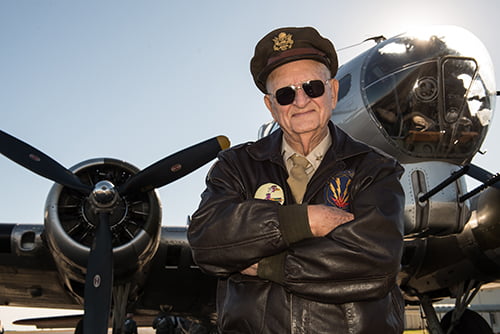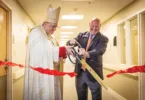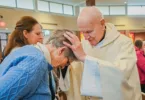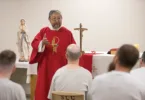
Thanks to relatives and the Experimental Aircraft Association of Oshkosh, Wisconsin, World War II pilot Emerson H. Shields had an opportunity to go up in the “Aluminum Overcast,” a vintage B-17 bomber similar to those he flew over Nazi Germany. The flight took place last fall at Topeka Regional Airport, formerly Forbes Army Air Field. Leaven photo by Joe Bollig
by Joe Bollig
joe.bollig@theleaven.org
TOPEKA — What does death look like at 25,000 feet? Emerson H. Shields knows, because he saw it.
Shields, 91, saw men die in the violent air battles over Europe during World War II from the best seat in the house, if you can call it that. He was a B-17 bomber pilot in the 360th Squadron of the “Hell’s Angels” 303rd Bomb Group, Eighth Air Force.
Once, these Flying Fortresses darkened the skies by the thousands. Now, some 70 years after the end of World War II, fewer than 50 complete B-17 airframes exist and, of these, only 15 or fewer are still airworthy.
As for the men who flew and fought in them, they’re becoming rarer, too. Shields is the last survivor of his old crew.
After the war, Shields was demobilized in 1946 and came home to Kansas. He became an attorney, and then a Catholic, in 1951. He and his wife Jeanette married in 1952. Together, they raised three sons and have been members of St. John the Apostle Parish in St. Johns for more than 65 years.
The war faded into the past, but never entirely disappeared.
“We had an older cedar chest in the basement filled with memorabilia he collected during the war,” said middle son Russell Shields, a member of Sacred Heart Parish in Shawnee. “When we were little kids, we used to go down and look at his things — old aircraft instruments, some of his uniforms, his oxygen mask.”
With time and mortality taking their toll, it’s all the more remarkable that the old flyboy was recently reunited with a familiar warbird.
Last fall, Shields was invited to the Topeka Regional Airport (formerly Forbes Army Air Field) to fly aboard B-17 G-VE, No. 44-857-40, aka “Aluminum Overcast,” owned by the Experimental Aircraft Association of Oshkosh, Wisconsin. The plane was in Topeka on a national tour.
Shields had been invited as a special guest. He showed up wearing his original uniform and reproduction leather jacket with authentic patches. He’d visited B-17s in museums, but it had been 70 years since he’d been in a “live” B-17.
“Gosh, the plane was sure not as big as I remembered it was,” he later said. “The engines seemed closer. [Aluminum Overcast’s] 104-foot wingspan is the same as what we had before, but it seemed smaller to me. The engines seemed closer.”
That cockpit and controls were familiar, with the exception of a few necessary modern additions. If the need or opportunity arose, could he still fly the old Fortress?
“No question about it,” said Shields.
Joining Shields on the flight were Jeanette; youngest son Scott Shields, a member of Corpus Christi Parish in Lawrence; and oldest son Byron Shields, a member of Holy Trinity Parish in Lenexa.
During the war, missions could last more than nine hours, but the flight over Topeka lasted less than 20 minutes.
Shields was 20 years old, a freshly minted second lieutenant, when he arrived at RAF Molesworth, Cambridgeshire, England, in early February 1945.
He had an inauspicious introduction to the 303rd.
On his first night at Molesworth, he was invited to go up with a pilot practicing night landings. The first two were great.
“But then [on] the third landing, the copilot hit too hard and the right landing gear folded back under the wing,” said Shields. “[The pilot] gave her the throttle and took off on one wheel. We flew around for 20 minutes and the operations officer told him to land on one wheel. This was at night.
“And so when we came down and landed on that one wheel. The plane spun around and we ran for the rear exit. The guy in front of me stumbled over the ball turret. I went on. The plane was lopsided, so I went out the door . . . and fell flat in a mud puddle. I stood up, and the fire trucks shot me full of foam.”
Shields started out as copilot and one of the nine crew members of “My Darling,” a veteran of 75 missions. He would fly other planes later, one named “Yankee Girl” and some with no names. In all, Shields flew 16 combat missions, doing the later ones as a first lieutenant and pilot of his own planes.
By the time Shields made it into the action, the war was almost over, but flying was still a dangerous business even for training missions and “milk runs.” German air defenses were seriously degraded by 1945, but they could still maim and kill.
Although his plane was never attacked by German fighter aircraft, he witnessed attacks on other B-17s by ME-109s, as well as the new and terrifying jet-powered ME-262s. Some other B-17s were shot up, burned, exploded and crashed.
Some limped home with dying and wounded crew members.
On one mission, antiaircraft artillery called “flak” left more than 50 holes in his aircraft and wounded the ball turret gunner, located in the aircraft’s belly.
His first combat mission was a coking plant at Gelsenkirchen on Feb. 19, 1945. His last was the railroad marshaling yards at Trunbrietzen, near Berlin, on April 20, 1945. When the war ended, Shields was reassigned as a travel booking agent for officers in Munich until sent home.
Today, some call Shields a hero. To Scott Shields and his brothers while they were growing up, he was just “Dad.”
“We knew what he did, but we only realized the magnitude when we got older,” he said.
The same is true for their father’s faith, which his sons have grown to appreciate more as they grew into theirs.
“[His faith] has always been strong,” said Scott Shields. “He’s really dedicated. He believes in it so much that it really makes a difference.”






